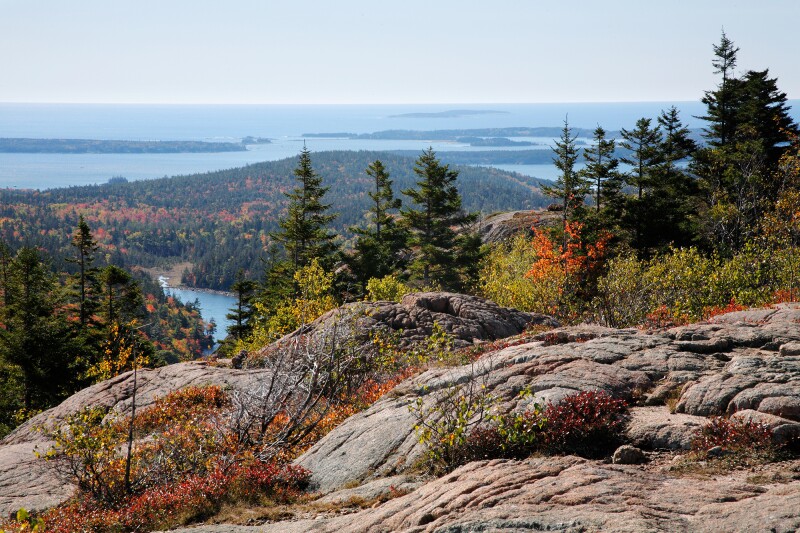Acadia National Park is set to join Muir Woods and Haleakala National Park in instituting a timed-entry reservation system for certain popular spots starting next summer. But if you’re planning on visiting this fall, you might want to check the park website: The Portland Press Herald reports that the park is considering a two- to three-week dry run of the system in October so that officials will have a better idea of what to expect.
The permit system is designed to solve problems of gridlock traffic and illegal, unsafe roadside parking during peak season at the busiest areas of the park, including Cadillac Mountain, Ocean Drive, and Jordan Pond.
Located in Maine, Acadia is the seventh most visited national park and welcomes around 3.5 million visitors annually. But it just wasn’t designed to accommodate such numbers. On February 3, 2020, superintendent Kevin Schneider told the Acadia Advisory Commission that on an average summer morning, there are 450 cars parked in and around the 100-car lot at Cadillac Mountain—meaning that hundreds are parked illegally and potentially in unsafe locations. Congestion can get so bad that the park website has an entire page dedicated to tips for avoiding the traffic.

The view from Cadillac Mountain may be serene, but the spot’s parking lot is a mess.
Photo by Shutterstock
Visitors will only need to reserve permits during the summer and only for the Ocean Drive road and for the parking lots at James Pond and Cadillac Mountain. It’s a timed-entry system, so visitors will have a specific window between the hours of 7 a.m. and 5 p.m. during which they’re allowed to enter the restricted areas. There will be no limit to how long they can stay. Permits will be required between the second Friday in June and the Sunday following Columbus Day and may cost $10, in addition to the $30 park entrance fee. The daily permit window for Cadillac Mountain will start earlier and end later because sunrise and sunset are popular times at the summit.
The new reservation system is only part of a larger plan to improve transportation at Acadia, which was finalized in May 2019 and will likely take up to a decade to complete. The plan also includes the construction of a new visitor center with expanded parking at Hulls Cove, which will function as a park and ride, encouraging visitors to explore using the existing Island Explorer shuttle system.
Congestion and overcrowding have increasingly caused problems for the country’s most popular national parks and many are exploring their own solutions. Yosemite now restricts access to areas around Horsetail Falls during the popular firefall event in February, and, as recently as this past September, the park has discussed a parking permit system in crowded places including the Glacier Point Road. In Utah, Arches National Park scrapped a plan to implement a reservations system in March of 2019 after it was determined that the program could cost southern Utah an estimated $22 million in tourist revenue. And this past Monday, all six members of Utah’s bipartisan congressional delegation announced that they would oppose a possible similar plan at Zion National Park.
Which national parks currently require reservations?
When Acadia’s reservation system goes into effect, it’ll be the fourth national park site to require permits to certain areas or at certain times of year.
Haleakala National Park
In Hawaii, visitors need permits to watch the sunrise from the summit of Haleakala at any time of the year. Permits cost $1 (in addition to the park entrance fee of $30) and can be purchased online up to 60 days in advance. Permits are required only between 3 a.m. and 7 a.m. Those interested in seeing the summit after sunrise do not have to purchase a permit.
Great Smoky Mountains National Park
Every year, visitors interested in watching the synchronous fireflies in the Smokies—an event that takes place in late May or early June—need to reserve a coveted permit, which is awarded via a lottery. Winners can then park in the Sugarlands Visitor Center on their designated day and ride the shuttle to the Elkmont viewing area to see the largest gathering of synchronous fireflies in the Western Hemisphere. During this time, permits are not required to access other parts of the park.
Muir Woods National Monument
In January of 2018, Muir Woods became the first national park site to require reservations year-round. The 554-acre grove of coast redwoods, the tallest tree in the world, was getting more than 1 million visitors per year—that’s a third of the visitors the 48,000-acre Acadia National Park sees. Because the parking lot at Muir Woods has only 232 parking spaces, people were parking up to a mile away along the narrow, winding road that leads up to the park entrance. Now, visitors need to reserve a parking spot for $8.50 or a seat on the shuttle for $3.25.
However, the jury is still out on how effective the reservations system has been for Muir Woods. According to the Marin Independent Journal, rangers claim that the system has made a world of difference at the park and that they’ve seen 100 percent compliance. But locals disagree, stating that they still frequently count 100 to 400 illegally parked cars near the monument on weekends. Either way, visitor numbers did decline by about 100,000 people during the first year, and the long-term effects still remain to be seen.
>>Next: 6 Dream Hikes in the United States (and How to Score the Permits)











